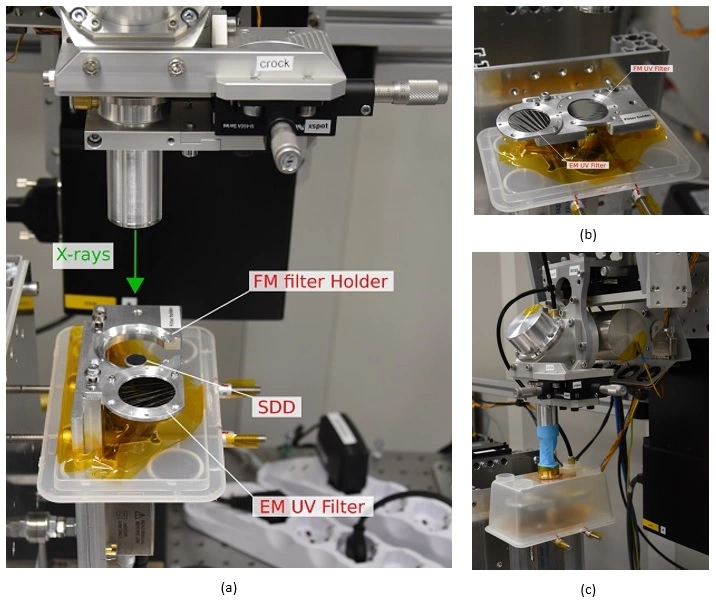The Stray-light Collimator (SLC) & ions-UV filters

STRAY-LIGHT COLLIMATOR (SLC)
An extensible boom connects the mirror modules to the spacecraft top-deck. A tapered stray-light carbon-fiber (CF) collimator collects only the photons reflected by the optics, thanks to fixed X-ray shields around the mirror modules, too. The total thickness is 1.25 mm and includes the 1-mm thick CF with an external 50-µm molybdenum coating of thickness and 20 µm gold in the intersections.
IONS-UV FILTER
Due to the fact that the beryllium window of the detector and the supporting titanium frame is at high potential (about -2800 V) positive ions may interact with the top GPD structure producing eventual secondary photons and a possible failure of the high voltage system. For this reason, photons from the optics cross a UV-ion filter made by LUXEL corp. composed of 1059 nm of LuxFilm® (based on kapton) with an external coating of 50 nm of aluminum and an internal coating of 5 nm of Carbon. The scope of UV-ions filter is to prevent that UVs and low velocity plasma present in orbit reach the beryllium window of the GPD.
EXPERIMENTAL SET-UP FOR MEASURING THE X-RAY TRANSMISSION
Ions-UV filter transmittance measurements were performed at INAF-IAPS with the Instrument Calibration Equipment (ICE). This is a customized facility developed at INAF-IAPS to perform the on-ground calibration of the IXPE DUs, and it is installed in an ISO 7 (10,000 class) cleanroom. ICE provides X-ray beams of know energy, polarization degree and angle. The X-ray beam and the DU are aligned by means of micrometric movement stages. The ICE comprises o -the-shelf auxiliary detectors: a Silicon Drift Detector (SDD) spectrometer and a Charge Coupled Device (CCD) to fully characterize the energy and the shape of the beam.

The IXPE DU ions-UV filters underwent acceptance and qualification at unit level in compliance with the Environmental Design and Test Specification (EDTS) for IXPE Spacecraft components. As required by the EDTS, the acoustic qualification was done through the application of random vibrational loads. The protoflight vibration test on the units was concluded successfully and the structural requirements were verified. No damage has been detected by the visual inspection performed after each axis vibration.
The X-rays transmittance was measured at INAF-IAPS for all the filters. Luxel Corp. measured the transmission of visible light of ions-UV filters with its Transmission Imaging Photometer (TIP). The TIP directly compares the intensity of a di use broadband visible (400 nm to 700 nm) light source both unattenuated and attenuated by each ions-UV filter for a high-sensitivity, spatially-resolved transmittance measurement.
STABILITY OF COUNT RATE AND TRANSMITTANCE MEASUREMENTS
A variation of the count rate of the source could affect the measurement of transmittance. During the test, the X-ray source was turned on and off. Thus, we estimated its stability.
During the on ground calibration activities of the IXPE detector units performed at INAF-IAPS, the X-ray transparencies of the DU-FM ions-UV filters were measured with monochromatic radiation at 2.7 keV and 6.4 keV. The transparencies are compatible with respect to the nominal values, including the mechanical tolerances of the thicknesses of the materials.
September 7, 2021

